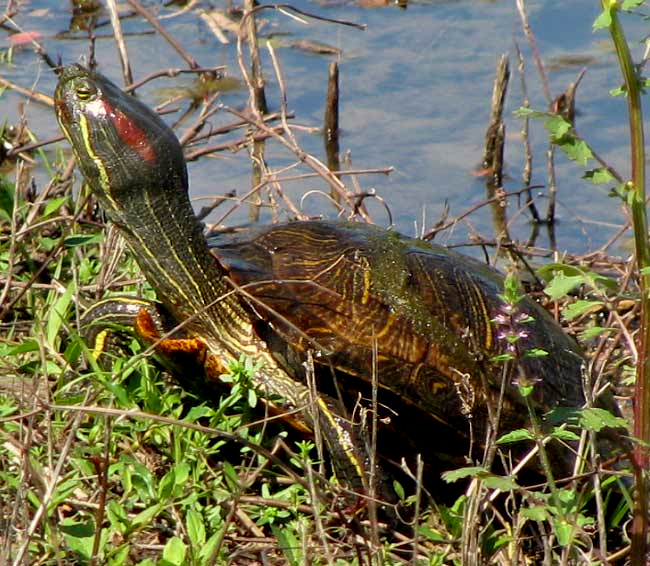TURTLE WATCHING
If you go turtle watching at a park or reserve, be sure to take along binoculars or, even better, a telescope, so you can identify what you see. Turtle identification at a distance can be hard, especially since the field marks separating many species are details of color and design of the shell, which may be hidden beneath moss or mud.

In most of the eastern and central US, if a high-backed turtle from a nearby natural or semi-natural area wanders into your dry backyard, it'll probably be a an Eastern Box Turtle, Terrapene carolina. You'll see in your field guide that there is also a Western species of box turtle, and that both the Eastern and Western species are separated into different-looking subspecies.
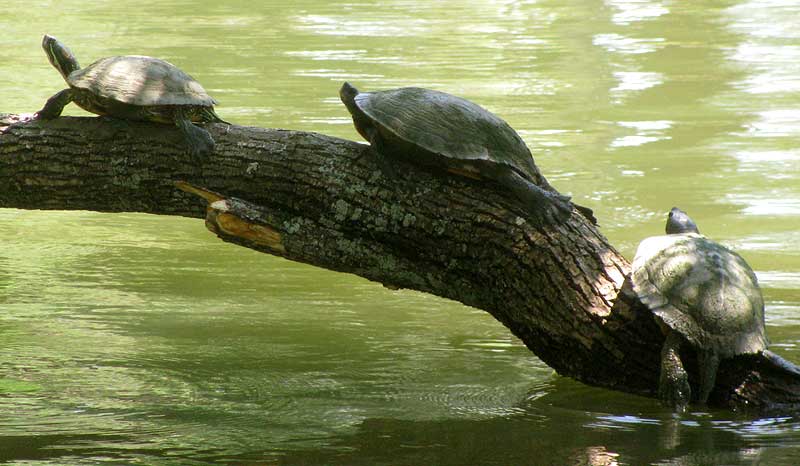
Similarly, throughout North America and much of the rest of the world, if you see turtles basking near pond water, like those above, there's a good chance they'll be the species in the picture, Red-eared Sliders. Red-eared Sliders are native to the southern US and northern Mexico. However, they're also the world's most popular pet turtle, so in many countries they have escaped and been released, becoming a serious invasive species negatively impacting local wildlife.
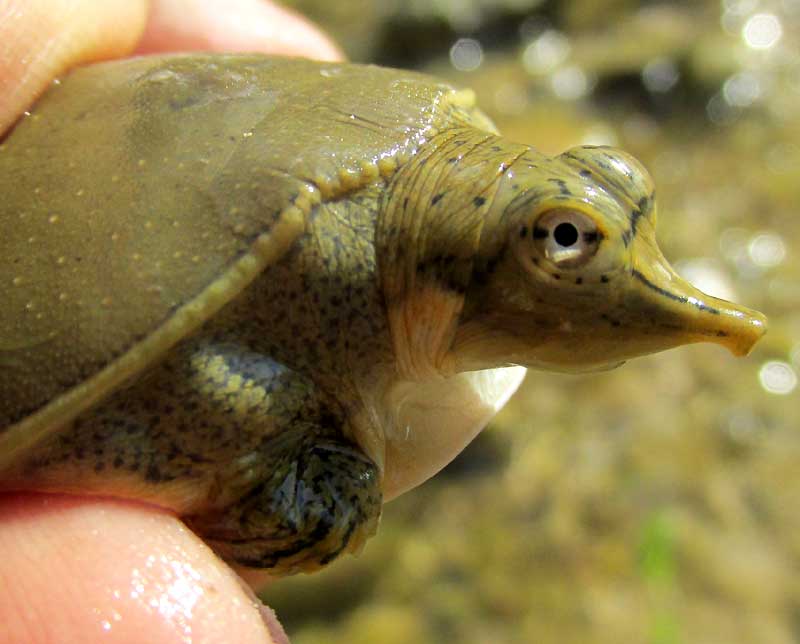
In most of the US, if you see basking turtles like those above, and they are not Red-eareds -- something like the Spiny Softshell Turtle, Apalone spinifera, shown at the right -- you'll be lucky, and you need to bring out the field guide and start identifying.
In the whole world, as of the year 2021, a little more than 350 turtle species are recognized. In the US about 57 of those species can be seen, Canada has about ten, and Europe about five. About half of Earth's turtle species are threatened with extinction, mostly because of habitat destruction by humans, including pollution and climate change, but also because of human consumption of turtle flesh, and the pet trade.
TURTLES, TORTOISES & TERRAPINS
Let's clarify these three terms:
- Turtle is a general term used for all turtle-like animals -- members of the order Testudines. As such, all tortoises and terrapins are also "turtles."
- Tortoise is a word often applied to any large, land-dwelling turtle, including the Eastern Box Turtle shown above. However box turtle species are members of the genus Terrapene, so you'd think people would call them Terrapins, but they don't.
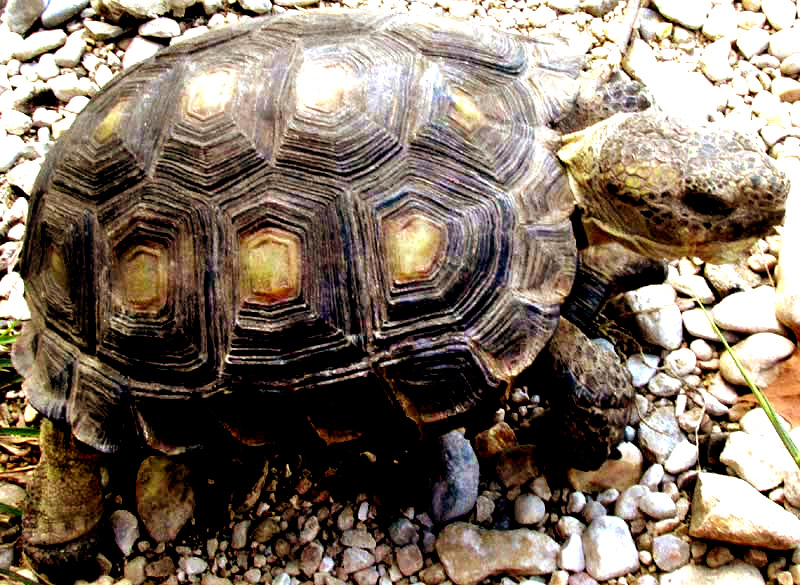 Technically the term "tortoise" is used to specify land turtles of the Tortoise Family, the Testudinidae, such as the Texas Tortoise, Gopherus berlandieri, shown at the right. In North America the Tortoise Family is represented by only that one genus, Gopherus, with species occurring in the US Deep South, southern Texas, and the Desert Southwest. Members of this genus, known as gopher tortoises, stay on dry land, have high, dome-shaped top-shells, and their powerful hind legs are so stubby that they almost look like elephants' legs.
Technically the term "tortoise" is used to specify land turtles of the Tortoise Family, the Testudinidae, such as the Texas Tortoise, Gopherus berlandieri, shown at the right. In North America the Tortoise Family is represented by only that one genus, Gopherus, with species occurring in the US Deep South, southern Texas, and the Desert Southwest. Members of this genus, known as gopher tortoises, stay on dry land, have high, dome-shaped top-shells, and their powerful hind legs are so stubby that they almost look like elephants' legs. - Terrapin is a term of the indigenous American Algonquian origin applied to several edible North American turtles living in fresh or brackish water. Terrapins often seen on logs protruding from water. When they spot you, they instantly slide into the water, then, in a few minutes, if you sit on the bank awaiting them, their heads will poke from the water here and there all over the pond. It's OK to call any hard-shelled, edible, freshwater or brackish-water turtle a terrapin. Therefore, the abundant Red-eared Slider, which many called a Red-eared Turtle, cal also be called Red-eared Slider. Be thankful for the technical binomial, Chrysemys scripta.
THE FAMILIES OF TURTLES
A good start to appreciating turtle diversity is to pay attention to the various turtle families. Worldwide, as of 2021, many experts recognize 14 families of living turtles. Wikipedia has a chart showing the 14 turtle families. Below is a list of those represented in North Amearica
- Family Chelydridae (snapping turtles)
- Family Emydidae (terrapins)
- Family Testudinidae (tortoises)
- Family Trionychidae (soft-shelled turtles)
- Family Kinosternidae (mud & musk turtles)
- Family Trionychidae (softshell turtles)
- Family Cheloiidae (sea turtles)
- Family Dermochelyidae (Leatherback Sea Turtle)
TURTLE CONSTRUCTION
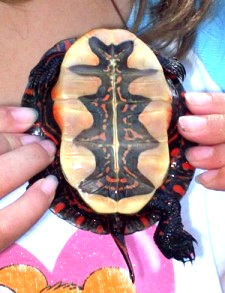
The next time you see a turtle, take the time to admire its beautiful adaptations. A turtle's most interesting adaptation is its shell. The turtle's top shell is known as the carapace, while the bottom shell is the plastron. That's a plastron at the right.
Both the carapace and plastron are composed of merged, block-like scales or plates, technically known as scutes or "scuta." The pattern made by the scutes' arrangement is a great help during the identification process. It's best to not pick up wild turtles, but if the identification is important, a picture of the plastron like that at the right will be helpful. If you can examine the plastron, notice whether the front part of the shell hinges up when the turtle pulls in his head, or if all one solid, unhinged piece. Some turtle groups have hinged plastrons, others fixed.
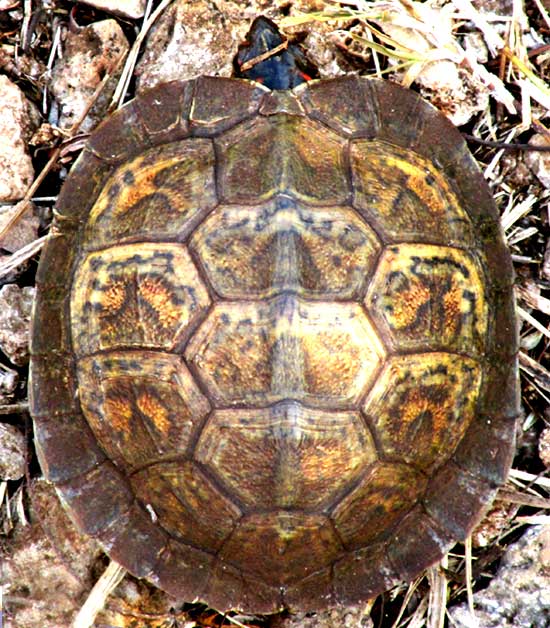
The carapace's scute pattern may be even more diagnostic. Using the scute pattern, the turtle at the left was identified as a young Furrowed Wood Turtle, Rhinoclemmys areolata, native to southern Mexico and northern Central America.
If you ever find a carapace lying on the ground, where the rest of the turtle has rotted away, you'll see how the turtle's backbone runs down the middle of the carapace's inner face. That suggests that the carapace is basically the turtle's enlarged and fused-together ribs, which most experts agree with. One curious thing about turtles is that they don't have teeth, which other reptiles do. Instead, they possess an almost bird-like horny beak. (Birds evolved from reptiles so this isn't surprising!)Speaking of birds, like birds, all turtles lay eggs. When egg-laying time comes, the mother typically digs a hole, lays her hard-shelled eggs in it, then fills the hole with earth, and leaves. After an incubation period, which may be as short as 6 weeks or more than 7 months, the hatchlings must dig their way to the surface.
Turtle design, compared to that of other reptiles, is so bizarre that paleontologists have a hard time figuring out how they evolved and where they came from. It's easier to explain how birds arose from reptiles than how turtles appeared among their fellow reptiles!
KEEPING TURTLES
It's always a temptation to capture turtles for pets. If you spot one, it's best to leave it alone or, if it appears to be headed for disaster as by crossing a busy highway, it should be carried back to its park or reserve. Box turtles usually withdraw into their box if approached, so picking them up is easy. However, they do have long necks so they can quickly twist around their heads and bite very hard. If a child absolutely must watch a turtle in captivity for a day or two, box turtles eat slugs, earthworms, strawberries, mushrooms and, in a pinch, white bread mashed into lumps. White bread is so low in nutrition, however, that it shouldn't be fed for long.

